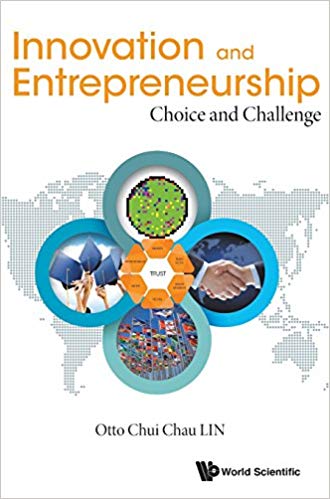This book discusses practical issues of innovation and entrepreneurship. It first outlines the basic factors contributing to economic growth in the knowledge-based economy. Portraying wealth creation as taking scientific research results from lab to market, it identifies two interlinking components of the innovation process: turning scientific research to industrial technology and nurturing an eco-system conducive to technology business. Thus, it clarifies the position and role of four institutional players of the national innovation system: university (U), technology institute (T), government (G) and business (B). Making these players interact synergistically provides a fertile environment for innovation and entrepreneurship. The development of Silicon Valley, Hsinchu, Shenzhen and Singapore are illustrated as examples.
For the technology entrepreneur, having a novel technology or unique product does not guarantee commercial success. It requires an effective business model, ability to execute business plan and entrepreneurial culture, all related to the soft power attributes of the entrepreneur team. The competitiveness of innovation and management of entrepreneurship are analyzed based on the concepts of Laozi and Confucius.
Every entrepreneurship must learn to manage the challenges brought about by the changing business environment. The competitiveness and sustainability of a business is reflected by its ability to manage the change, both in bad and in good times. Every choice it makes will bring about new challenge. This is a definite, continuous and cyclic phenomenon occurring to all types of business. Some case examples of success or failure in managing challenges are given. They include: Alibaba Group, Ardentec IC testing, Cisco Systems, Delta Electronics, Eastman Kodak, Epistar HBLED, Fairchild Semiconductors, General Motors, GIANT carbon fiber bicycles, Tencent Holdings, TSMC, Volkswagen and others.
This book is based on the author's practice and observation in technology and economic development especially in the Asia Pacific region during the post-1990s period. It is intended to be a reference of best practices for entrepreneurs, corporations and countries striving to make its mark in the knowledge-based economy.
Readership: Students, researchers and practitioners who are interested in learning more about the practical issues of innovation and entrepreneurship in the Asia Pacific region, especially about Taiwan.
چکیده فارسی
این کتاب در مورد مسائل عملی نوآوری و کارآفرینی بحث می کند. ابتدا عوامل اساسی مؤثر در رشد اقتصادی در اقتصاد دانش بنیان را تشریح می کند. با به تصویر کشیدن ایجاد ثروت به عنوان انتقال نتایج تحقیقات علمی از آزمایشگاه به بازار، دو جزء به هم پیوسته فرآیند نوآوری را شناسایی می کند: تبدیل تحقیقات علمی به فناوری صنعتی و پرورش یک اکوسیستم مساعد برای تجارت فناوری. بنابراین، جایگاه و نقش چهار بازیگر نهادی سیستم ملی نوآوری را روشن می کند: دانشگاه (U)، موسسه فناوری (T)، دولت (G) و تجارت (B). ایجاد تعامل این بازیکنان به صورت هم افزایی، محیطی حاصلخیز برای نوآوری و کارآفرینی فراهم می کند. توسعه دره سیلیکون، هسینچو، شنژن و سنگاپور به عنوان نمونه نشان داده شده است.
برای کارآفرین فناوری، داشتن یک فناوری جدید یا محصول منحصر به فرد موفقیت تجاری را تضمین نمی کند. این نیاز به یک مدل کسبوکار مؤثر، توانایی اجرای طرح کسبوکار و فرهنگ کارآفرینی دارد که همگی با ویژگیهای قدرت نرم تیم کارآفرین مرتبط هستند. رقابت پذیری نوآوری و مدیریت کارآفرینی بر اساس مفاهیم لائوزی و کنفوسیوس تحلیل می شود.
هر کارآفرینی باید یاد بگیرد که چالش های ناشی از تغییر محیط کسب و کار را مدیریت کند. رقابت پذیری و پایداری یک کسب و کار با توانایی آن در مدیریت تغییر، چه در زمان بد و چه در زمان خوب، منعکس می شود. هر انتخابی که انجام دهد چالش جدیدی را به همراه خواهد داشت. این یک پدیده قطعی، پیوسته و چرخه ای است که در همه انواع کسب و کار رخ می دهد. نمونه هایی از موفقیت یا شکست در مدیریت چالش ها آورده شده است. آنها عبارتند از: گروه Alibaba، تست IC Ardentec، سیستم های سیسکو، دلتا الکترونیک، Eastman Kodak، Epistar HBLED، Fairchild Semiconductors، General Motors، دوچرخه های فیبر کربن GIANT، Tencent Holdings، TSMC، Volkswagen و دیگران.
این کتاب بر اساس تمرین و مشاهدات نویسنده در زمینه فناوری و توسعه اقتصادی به ویژه در منطقه آسیا و اقیانوسیه طی دوره پس از 1990 است. در نظر گرفته شده است که مرجعی از بهترین شیوهها برای کارآفرینان، شرکتها و کشورهایی باشد که تلاش میکنند نشان خود را در اقتصاد دانشمحور بگذارند.
خوانندگان: دانشآموزان، محققان و شاغلانی که علاقهمند به کسب اطلاعات بیشتر در مورد مسائل عملی نوآوری و کارآفرینی در منطقه آسیا و اقیانوسیه، بهویژه در مورد تایوان هستند.
ادامه ...
بستن ...










